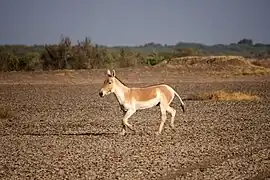Little Rann of Kutch
The Little Rann of Kutch[1][2] is a salt marsh which is part of the Rann of Kutch in Kutch district, Gujarat, India.


Attractions

Indian wild ass sanctuary
The Little Rann of Kutch is home to the Indian wild ass (khur). To conserve this species, the Indian Wild Ass Sanctuary (IWAS) was created in 1971 and covers nearly five thousand square km.[3] The sanctuary is also home to many species of migratory birds, such as the sarus crane, ducks, the Dalmatian pelican, and flamingoes, as well as land birds like the sandgrouse, the francolin and the Indian bustard. It is also home to various mammals such as the Indian wolf, desert fox and nilgai.
Kutch biosphere reserve
In 2008, to project Kutch as an international nature destination, the Government of Gujarat designated the area as the Kutch Biosphere Reserve. Biosphere reserves aim to promote sustainable development in the surrounding area, which is reserved for conservation and research. Such reserves are protected under the Wildlife Protection Act, the Indian Forest Act and the Forest Conservation Act. The government provides funds for the conservation of the landscape's biological diversity and its cultural heritage.
The reserve's vegetation is mainly xerophytic as groundwater is scarce. The 74 elevated plateaus (also called islands or bets) have around 253 flowering species. According to some estimates, about 70,000 to 75,000 birds nest in an area of about 250 acres.[4][5][6]
Economy

Salt panning
Salt panning is a crucial seasonal activity in the Rann of Kutch, producing the majority of India's inland salt. During the monsoon season, the underwater table of the Kutch is filled with saltwater. After the water recedes in October, salt workers temporarily settle and use diesel pumps to pump the saltwater into fields. Then, the natural climate conditions allow evaporation of the water, leaving only the salt crystals. Salt panning workers face severe health issues due to working in the harsh conditions in the fields continuously for 6–7 months.[7] In 2019, as a means of financially supporting the salt pan workers and promoting a move from diesel to solar-powered pumps, the government of Gujarat allowed the state to purchase excess solar power generated during the off-season. Using solar-powered as opposed to diesel pumps can reduce the cost of salt production by one-third.[8]
Ginger prawn fishing
Prawn fishing plays a role in the economy due to its high demand in domestic and international markets. Ginger prawn (Metapenaeus kutchensis) are endemic to the area, and their fishing is highly seasonal. During the monsoon season, which begins around July, the Little Rann is flooded and temporarily connected to the Gulf of Kutch, allowing passage of ginger prawn juveniles into the Rann. This marks the beginning of the prawn fishing season, which lasts from August to September. Fishermen are mostly seasonal workers, spending the majority of the year as salt pan workers.
Ginger prawn fishing dates back to the early 16th century, when it was practiced by Muslim subsistence fishermen during the Mughal dynasty. Their method, known as "Pagadia fishing" due to its being carried out by hand and barefoot, continues to be practiced by traditional fishermen in the region. Commercial prawn fishing only began in the mid-1900s after the use of bottom trawls became common.[9]
Dam
The Government of Gujarat is planning to dam the 1.26 km stretch of Hadakiya Creek so that the water within it can be used for recreational and fisheries purposes.[10]
References
- Needed in the Little Rann of Kutch, a marketing strategy worth its salt to help the Agariyas (2 page article online); by Adam Halliday; Jul 15, 2009; Indian Express Newspaper
- RTI revelation: govt has no data on Little Rann of Kutch (2 page article online); by Kamran Sulaimani; Feb 03, 2009; Indian Express Newspaper
- "Wild Ass Sanctuary". forests.gujarat.gov.in. Retrieved 30 March 2020.
- "Wild Ass Sanctuary, Little Rann of Kutch". UNESCO. 2015. Retrieved 30 March 2020.
- Kutch gets biosphere reserve status - The Greater and Little Rann of Kutch have finally got the much-awaited status of the biosphere reserve.
- Kutch’s wild ass habitat may soon get heritage label (2 Page article online); by DP Bhattacharya; Jul 26, 2007; Indian Express Newspaper
- Mukherjee, Sugato (3 October 2016). "The Salt Farmers of the Rann of Kutch". The Diplomat. Retrieved 31 March 2020.
- Pathak, Maulik (6 Feb 2019). "Gujarat government to buy solar power from salt pan workers". LiveMint. Retrieved 31 March 2020.
- Gyanaranjan Dash, Swatipriyanka Sen,M Koya, KR Sreenath, Suresh Kumar Mojjada, and HM Bhint (2012). "Ginger Prawn Fishery in Gulf of Kutch: A Seasonal Livelihood for the Traditional Fishermen" (PDF). Central Marine Fisheries Research Institute. Asian Agri-History Vol. 16, No. 4: 1–9.
{{cite journal}}: CS1 maint: multiple names: authors list (link) - "Eye on 2019 polls? Tycoon discusses with Modi, Amit Shah Asia's biggest Rann Sarovar sweet water lake in Gujarat". Retrieved 9 June 2018.
- "Rann of Kutch seasonal salt marsh". Terrestrial Ecoregions. World Wildlife Fund. This text was originally published in the book Terrestrial ecoregions of the Indo-Pacific: a conservation assessment from Island Press. Also see: World Wildlife Fund, ed. (2001). "Rann of Kutch seasonal salt marsh". WildWorld Ecoregion Profile. National Geographic Society. Archived from the original on 2010-03-08.